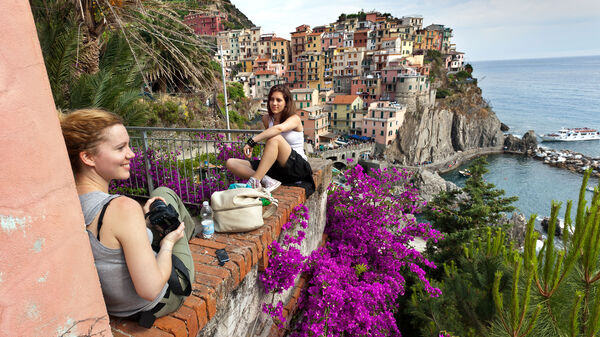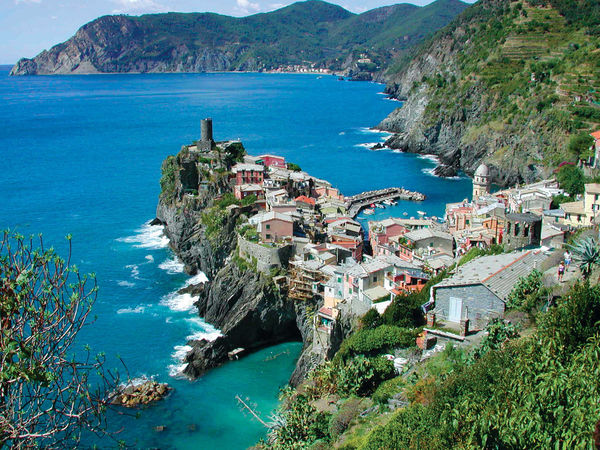The Enchanting Cinque Terre: Fiat-Free Italy
Each of the Cinque Terre's five villages is a well-whittled, pastel jumble of homes clinging to the rocky, isolated stretch of coast like crusty sea creatures in a tide pool.
By Rick Steves

I'm up early in my favorite village on the Italian Riviera, as the morning sun touches the tip of Vernazza's bell tower and greets a peaceful world. The air is damp, cool, and refreshing as I wander downhill, passing underneath the train tracks. I enjoy the fact that the town is essentially traffic-free, and realize that many of my favorite Italian towns — like Venice, Siena, Tuscany's Volterra, and Lake Como's Varenna — are all this way.
Fiat-free Italy…just the way I like it.
Along a beautifully isolated six-mile stretch of the northern Italian coast lie the five small, dramatically set towns of the Cinque Terre. Each village is a variation on the same theme: a well-whittled, pastel jumble of homes — some perched on steep hillsides, some sloping into ravines — clinging to their hillsides like crusty sea creatures in a tide pool. Locals are the barnacles — hungry, but patient. And we travelers are like algae, coming in with the tide.
All five are nestled among the rocky vineyards that have allowed generations to quietly flourish here. With a traffic-free charm — a happy result of their natural isolation — these towns are the rugged alternative to the glitzy Riviera resorts nearby. This is the place to take a sightseeing breather, and inhale slower-paced Italian culture in perhaps its purest form.
Enjoy the villages, swimming, hiking, and evening romance of one of God's great gifts to tourism. While the Cinque Terre can be unpleasantly crowded in late spring and early fall (especially at midday, when tourist boats and cruise-ship excursions drop by), it doesn't take too much effort to steer (mostly) clear of the hordes. Given that the vast majority of the crowds are day-trippers, make a point to get the most out of those cool, relaxed, and quiet hours early in the day and in the evening.
Until the advent of tourism in this generation, the towns were poor and remote. Today, tourism stokes their economies and each is well connected by hourly trains. But traditions are resilient, there's not a chain store anywhere, and each of the five villages comes with a distinct dialect and its own proud heritage.
To preserve the Cinque Terre's natural and cultural wonders, Italy has declared the region a national park — towns and all. Visitors buy an inexpensive day pass to hike the scenic trail that laces together the unique communities.
Riomaggiore — the most substantial non-resort of the five towns, and the farthest south — is a fascinating tangle of colorful homes that lean on each other like drunken sailors. A cliff-hanging trail offers sweeping coastal views, passing castle ruins and two churches before leading to the town's tiny harbor.
The next town up, tiny Manarola, is a picturesque tumble of buildings bunny-hopping down its ravine to a wild little harbor. The trail ringing the town's cemetery, on the peninsula north of the main harbor, affords some of the most strikingly beautiful town views anywhere in the region. Find a cliffside café and enjoy tasty treats born right here: pesto on your focaccia, washed down by a glass of crisp local wine that glistens with the reflection of the Mediterranean. Talk about going local.
Corniglia, with its mellow main square, is the quiet town — the only one of the five not on the water. From the train station, a footpath zigzags up nearly 400 stairs to the hilltop town. According to legend, a Roman farmer originally settled Corniglia, naming it for his mother, Cornelia (which is how Corniglia is pronounced). Locals claim that its ancient residents produced a wine so widely exported that jars have been found at Pompeii stamped with the town name. Still, today, wine remains the town's lifeblood. Following the pungent smell of ripe grapes into an alley cellar, I find a local who lets me dip a straw into his keg.
If you ask me, the fourth town up — Vernazza — is the jewel of the Cinque Terre. Its action is at the harbor, where you'll find restaurants, a bar hanging off the edge of a ruined castle, a breakwater with a promenade, and a tailgate-party street market every Tuesday morning. While the old men putter with their tough little boats, the day's last bit of sunshine seems to sweep the old women and children into a warm corner in front of the church.
And Monterosso al Mare, the Cinque Terre's only resort town, comes with a few cars, lots of hotels, rentable beach umbrellas, crowds, and a thriving late-night scene. Its historic center cradles Old World charm within crooked lanes and hole-in-the-wall shops. Strolling the waterfront promenade, you can pick out each of the other Cinque Terre towns decorating the coast. After dark, they sparkle.
Vineyards, with their many terraces, fill the mountainsides beyond the towns. Someone — probably after too much local wine — calculated that the roughly 3,000 miles of terrace walls have the same amount of stonework as the Great Wall of China. Wine production is down nowadays, as younger residents choose less physical work. But locals still maintain their tiny plots and proudly serve their family wines.
Evening leisure time is centered around the slow-motion parade called the passeggiata, as locals do their vasche (laps) along each town's main drag. After three days here — sitting on a bench, gelato in hand, enjoying the endless "ciaos" and parade of neighbors — I feel a part of the scene. Here, I live the phrase "la vita pigra di Vernazza" (the lazy life of Vernazza).
I cap my Cinque Terre days on the breakwater with a glass of sciacchetrà dessert wine. At midnight, the Mediterranean is darker than the sky — except for bobbing lanterns on the horizon. By night, old-school fishermen are seducing anchovies into their nets. By day, the same guys are seducing me with a way of life that refuses to give in to the modern world.

